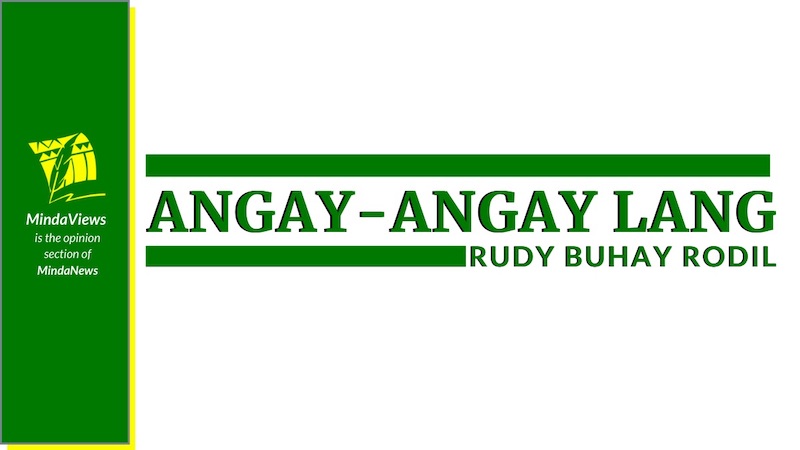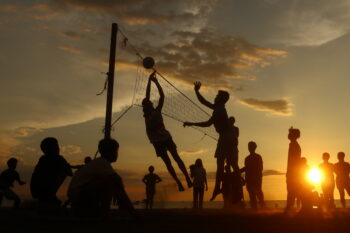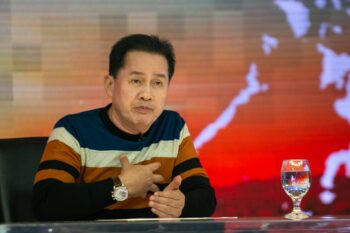
11th of 18 parts
Rudy B. Rodil
(This is a revised version of the book “KALINAW MINDANAW: The Story of the GRP-MNLF Peace Process, 1975-1996” published in 2000)
Chapter 5. In the Wake of EDSA: The Jeddah Accord and the 1987 Constitution
One of Mrs. Corazon C. Aquino’s first acts as president was to reach out to the MNLF leadership. Acting against all advice to the contrary, she met with Nur Misuari in his own base area and told him, “I am not your enemy.”
With the judicious use of her dictatorial powers, she had earlier created the Constitutional Commission and cranked up the machinery that would restore democracy in the system. Her unprecedented meeting with Nur Misuari led to the signing of the Jeddah Accord and the subsequent negotiation chaired by Amb. Emmanuel Pelaez. Time was of the essence. The Constitutional Commission had 90 days to finish its task; the government-MNLF negotiation, too, had 90 days to reach an agreement.
The Jolo Meeting
The unprecedented one-on-one meeting between President Corazon C. Aquino and Nur Misuari on September 5, 1986 in Jolo resulted in a Joint Statement which contained three important items. First, both parties agreed to uphold the “cessation of hostilities” which the President’s brother-in-law, Agapito “Butch” Aquino had arranged with the MNLF leader earlier; second, Nur Misuari would conduct his own “process of consultations with the leaders in the other provinces;” and, third, the government and the MNLF would hold “substantive negotiations” under the auspices of the Organization of Islamic Conference.
The cessation of hostilities went into effect immediately; Misuari conducted his version of consultation not very long after, and the negotiation was convened in the early part of January 1987.
Misuari’s Public Consultation
Misuari’s consultation caravan which lasted for three months was ferried in 20 big buses. With each bus containing an average of 60 passengers, mostly heavily armed mujahideen, that would easily come to a total of 1,200 people. He was in Marawi in the first week of October and would have wanted to cross over to Iligan but the military politely and firmly informed him that he could not proceed to Iligan with all his firearms. So, the MNLF went back to Cotabato City and proceeded to Davao, then to Surigao, then finally reached Iligan the roundabout way. He proceeded to Zamboanga City from there.
Misuari received overwhelming popular support in Marawi as in all Muslim-dominated areas. In contrast, the Iligan crowd was noticeably sparse and maintained a discrete distance. The Mindanaw State University-Iligan Institute of Technology (MSU-IIT) gymnasium where he conducted his consultation was not even full. The MNLF stayed overnight at the MSU-IIT campus. The following morning Misuari paid Mayor Alan Flores a courtesy call. About two weeks after the visit, Mayor Flores organized his own public consultation at the Iligan City High School grounds – the crowd was definitely larger than those that attended the MNLF consultation. All participants, from the most conservative to the most progressive, were unanimous, loud and unmistakable in their rejection of autonomy – they did not wish to be governed by the MNLF, they said. Local radio stations broadcast the event live.
While Misuari was busy with his democratic consultation, President Aquino organized the Constitutional Commission (Concom). By the time the negotiation at Jeddah met in the first week of January 1987, the Concom was done with its work. The plebiscite for ratification was set for February 2, 1987.
The draft constitution contained extensive sections on the establishment of the Autonomous Region in Muslim Mindanaw and the Cordilleras. The Tripoli Agreement was reportedly used as a basic reference in their deliberations on autonomy. It was these sections, which the MNLF panel later proposed through the Jeddah Accord, that President Corazon C. Aquino should suspend and not include in the plebiscite through an executive order. The President did not accommodate the proposal.
The Jeddah Accord
The GRP-MNLF negotiations at Jeddah produced the Jeddah Accord of January 3-4, 1987. It consisted of three documents. (1) Joint Statements of the Philippine Government and the MNLF Panels; (2) Summary of the points taken up in the meeting between the Philippine and the MNLF Panels held at the Organization of the Islamic Conference Headquarters, Jeddah, Kingdom of Saudi Arabia on January 3, 1987; and (3) Joint Statement of the MNLF and the Philippine Government Panels. Signatories in all three documents were Aquilino Pimentel, Jr., Chairman of the Philippine Government Panel; Nur Misuari, Chairman of the MNLF Panel, and S.S. Pirzada, Secretary General of the Islamic Conference, as witness. Pirzada affixed his signature only in the first document. Joseph Banghulot and Agapito Aquino also signed in the second document. Later, Amb. Emmanuel Pelaez took over as Chair of the Government Panel.
The main message in the Jeddah Accord is: “The two panels agreed to continue discussion of the proposal for the grant of full autonomy to Mindanaw, Basilan, Sulu, Tawi-Tawi and Palawan subject to democratic processes.”
The intended result of the Jeddah Accord was not accomplished. As agreed, the GRP-MNLF negotiation in Manila and in Zamboanga took place as scheduled to be completed “within 90 days,” from February 9 to May 9, 1987. The controlling element was said to be the new Constitution. The Government Panel insisted on working within its parameter, while the MNLF refused to do so.
In sum, it seems that the Jeddah Accord and its aftermath was a political experiment for both camps. It accomplished many firsts, alright: It was the first time that the OIC did not participate in the talks; it was the first time that the talks took place in the Philippines; it was the first and only time that Misuari did not lead the MNLF panel in such a major meeting; it was the first and only time that the Tripoli Agreement was not the main item in the agenda. Strangely, it was also the first time that all parties, the GRP, the MNLF and the OIC strayed from the Tripoli Agreement.
This writer asked Sen. Aquilino Pimentel recently through email why he signed the Jeddah Accord. His reply was “I signed the Jeddah accord because it had promised a beautiful beginning for the negotiations between the MNLF and the new government. For the first time since the MNLF had risen up in arms against the government in 1972, the talks would be held in the Philippines… By agreeing to negotiate with the government in Philippine territory, Nur, in effect, implicitly recognized the sincerity of the Aquino government in the search for peace in Mindanaw.”
With the failure of the talks, President Aquino went full swing into the implementation of the 1987 Constitution. She created the Regional Consultative Commission which helped draft the organic act for Muslim Mindanaw. Based on this draft, Congress enacted R.A. 6734. After the plebiscite of November 1989, the Autonomous Region for Muslim Mindanaw was in place.
Be that as it may, it must be admitted that the constitutional way opened new opportunities for other alternative approaches, most important of which is the participation of the greater number of people in the peace process.
The Regional Consultative Commission (RCC-MM); Creating the Autonomous Region in Muslim Mindanaw
The Constitutional Commission laid out the specific steps towards the creation of the Autonomous Region in Muslim Mindanaw in seven long sections of the 1987 Constitution, namely, Article X, Sections 15-21. And the very first step was the establishment of the regional consultative commission.
Fifty-two people composed the RCC-MM, drawn from the 13 provinces and 9 cities which constituted the territory of the autonomy in the Tripoli Agreement and happened to be subdivided into 27 congressional districts. Twenty-seven represented congressional districts. The rest were classified as at-large who represented special groups or sectors. So, altogether, there were 27 district commissioners and 26 at-large. Five (5) slots were kept vacant for members of Bangsamoro Fronts. The latter understandably kept their distance. Twenty-six (26) of these were Muslims, eight (8) identified themselves as Highlanders, and the rest were Christians. A 53rd member was confirmed by the Commission on Appointments on 29 September 1988, the day before the last session; he was unable to participate in the body’s deliberations. They took their oath of office on March 26, 1988. They were given six months within which to accomplish their task.
In terms of representation by ethnic group, it went as follows: the Muslims were distributed into seven Maguindanaon, seven Maranao, six Tausug, two Yakan, two Sama, and one convert but married to a Maguindanaon; the Highlanders were two Subanen, one part Subanen, two Bla-an, one T’boli, one Teduray and one Cuyunon. The imbalance among the Muslims may be explained by the appointment of at-large commissioners.
Team Building among Commissioners
Under R.A. 6649, the RCC-MM had 20 million pesos and 150 days within which to come up with a final report. Oath-taking was presided over by President Aquino herself on 26 March 1988, at Cotabato City. In her speech, the President stressed that she had a personal stake in the peace process.
The Commissioners spent five days, April 4-8, at the Asian Institute of Management, in a live-in seminar spiced with group dynamics, workshops and inputs from resource persons – for team building, and to acquire background information of the issues they were bound to address, the Peace Commission organizers said.
Atty. Jose Nolledo, a member of the Constitutional Commission, explained how the provisions on autonomous regions came into being; Rev. Joaquin Bernas, S.J., spoke on the Tripoli agreement; Ambassador Pacifico Castro recounted how the Philippine Government got entangled with the Organization of Islamic Conference which led to the Tripoli Agreement; and Dr. Marilou Palabrica-Costello of Xavier University shared the findings of the study-survey on autonomy done within the 13 provinces by a consortium of universities (Xavier, Ateneo de Davao, Notre Dame University, MSU-Marawi, Western Mindanaw State University).
The study found out, among others, that of the Christians who were asked if they wanted their place to be part of the autonomous region, nearly one hundred per cent replied “no”; a similarly negative response was given by the Lumad, and the Muslim respondents naturally answered in the positive, also by nearly one hundred percent. The survey impressed on everyone the odds faced by the entire Commission if the intention was to make autonomy acceptable in the 13 provinces and 9 cities. But morale among the Commissioners was high and odds of 7 to 3 or even 9 to 1 was nothing to be scared about, only a battle to be won.
Organizational Phase
The organizational phase at Zamboanga City lasted until April 19, 1988. The spirit of camaraderie and mutual accommodation was very visible among the members and the first result of this was to have a Muslim chairman and three vice chairmen, one each from the Muslims, the Lumad (called Highlanders in the Commission) and the Christians. Another was the decision to distribute committee membership on a 40-40-20 principle, meaning 40% Muslim, 40% Christians and 20% Lumad.
But as early as the nomination for the offices which was done by group, followed immediately by the selection of committee membership, this spirit would emerge for what it was: an illusion. To the Muslim act of submitting a single nominee for chairmanship, there were spontaneous but subdued reactions of “being violated” from some non-Muslims: sigurado ng kanila, hindi pa tayo pinadesisyon. (The position was already theirs; they could at least have allowed us to make a decision.) It should be pointed out that the Muslims violated no election rules approved earlier by the Commission.
Through whispers a joint Christian-Lumad meeting was convened at past midnight that same evening. More expressions of resentment were put forward. The discussions that followed led to a decision to strategize on how to capture the chairmanship of substantive committees. But apparently the Muslims did the same thing and, on the day of reckoning, cornered more substantive committees.
Public Consultations
In the months of May and June, the individual Commissioners went into the consultation process without any agreed format at the Commission level. There were attempts from Commissioners who had had research experience to propose a simple methodology but no specific methods nor specific goals were arrived at. It was clear enough what district Commissioners would be doing, but the same was not true with Commissioners-at-Large. Thus, consultation methods varied from one Commissioner to another.
There were those who went from one barangay to the next or to as many municipalities within their district; there were those who confined themselves to the specifics of their committees and consulted only with relevant groups; there were those who went to several districts; there were those who limited themselves to information drives through radio, and there were those who stayed at home and merely waited for constituents to come. Needless to say the results were as varied as the methodology.
On the whole, however, the consultation did produce substantial input, not so easy to quantify from a statistician’s point of view. But from a layman’s point of view, the trend in public opinion, based on given samples, clearly indicated that eight out of the 13 provinces were against their inclusion in the autonomous region. People’s comments could not indeed be reduced to mathematical terms, but creatively translated into specific proposals, as were later done by the Commissioners, led to a substantial draft organic act.
Within July and the first week of August, regional level consultations were conducted in Puerto Princesa City, Zamboanga City, Marawi City, Cotabato City and General Santos City. These further confirmed what the Commissioners had reported earlier.
Controversy over the Name “Muslim Mindanaw”
Easily the most controversial, meaning touchy issue in almost all the consultations was the name of the autonomy. Non-Muslims generally reacted with alarm over “Muslim Mindanaw.” This was taken as proof of their suspicion that the Muslims were out to dominate the government of the autonomy. Surprisingly, even Muslims (some being members of the MNLF) sensed the divisive effect of this name; some of the latter in Sulu even commented that the introduction of the phrase was a deliberate ploy on the part of the central government precisely to sabotage the struggle of the Bangsamoro for self-determination.
As early as May and June, the Commission was deeply aware of the temper of the people. Those opposed to the name and were automatically for non-inclusion of their respective places from the territory of the autonomy were the Christian dominated provinces and cities of Davao del Sur, South Cotabato, Sultan Kudarat, Cotabato, Lanao del Norte, Zamboanga del Norte, Zamboanga del Sur, Palawan, General Santos City, Cotabato City, Iligan City, Pagadian City, Dapitan City, Dipolog City, Puerto Princesa City and Zamboanga City. Generally in favor of inclusion in the autonomy were the Muslim dominated provinces of Maguindanao, Lanao del Sur, Basilan, Sulu, Tawi-Tawi and Marawi City.
Such consultation results reflected and confirmed the findings of the survey-study shared earlier by Dr. Costello. Except for Basilan and Marawi City, the results of the plebiscite in November 1989 were an accurate reflection of this trend. It would seem that the people voted based on whether or not they could identify with the autonomy in Muslim Mindanaw, not on the merit of the Organic Act.
Not surprisingly, the issue of the name became the dominating controversy in the entire Commission from the month of May and remained unresolved until the last day of the plenary deliberations. For those who were members of the Committee on Preamble, Regional Territory and Declaration of principles, of which this writer was one, being in the eye of the storm for four months was not exactly a pleasant experience. The turbulence that raged outside was intensely replicated within the Committee itself.
Unexpected Adjournment
The period from August to September, especially the last 11 days, was devoted to plenary session. In the evening of the last, September 30th, the Commission stopped the clock at exactly 11:53 PM and went on sine die session. At around 2:00 A.M., Commissioner Rustico Varela, chairman of the Committee on General and Transitory Provisions, walked out unexpectedly – two days after the event, he admitted to this writer that he did it deliberately – and shortly thereafter, after a brief recess and consultation, there was a motion for adjournment, and the Chairman declared the session indefinitely adjourned.
(MindaViews is the opinion section of MindaNews. A peace specialist, Rudy Buhay Rodil is an active Mindanao historian and peace advocate.)
Tomorrow: Status of the Draft Organic Act







